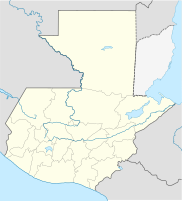San Jerónimo (Baja Verapaz)
| San Jerónimo | ||
|---|---|---|
|
Coordinates: 15 ° 4 ′ N , 90 ° 14 ′ W San Jerónimo on the map of Guatemala
|
||
| Basic data | ||
| Country | Guatemala | |
| Department | Baja Verapaz | |
| City foundation | 1601 | |
| Residents | 18,000 | |
| Detailed data | ||
| surface | 474 km 2 | |
| Population density | 38 people / km 2 | |
| height | 940 m | |
| Post Code | 15007 | |
| Time zone | UTC −6 | |
| City patron | St. Jerome (Feast: September 30th) | |
San Jerónimo is a large municipality ( municipality ) in the Baja Verapaz department in Guatemala . About 18,000 people live in the 474 km² large municipal area, the majority of them in San Jerónimo, the rest in 18 subordinate rural communities and 13 hamlets.
location
San Jerónimo is located in the east of the Baja Verapaz department at the end of the Salamá valley in a fertile hilly landscape. From Guatemala City it is about 150 km to San Jerónimo on the national road CA 9 and then on the CA 14 leading from El Rancho to Cobán .
The municipality of the same name borders in the southeast on the department El Progreso and otherwise on Salamá .
economy
San Jerónimo lives mainly from agriculture and the sugar industry. Since the place is a few kilometers west of the main road to Cobán, one does not particularly benefit from through traffic. The celebrations in honor of the patron saint Jerome held annually between September 27th and 30th are of tourist importance .
history
As part of the peaceful evangelization of the Verapaz region by Bartolomé de Las Casas , a first church and a settlement for the Dominicans were built in 1537 on the site of today's San Jerónimo . They are responsible for the construction of an irrigation system, as well as the cultivation of wine , which was soon marketed throughout Central America. In 1601 the Dominicans built a sugar mill and founded the company Hacienda San Jerónimo , which later employed over 1,000 people and became famous for its rum . In 1829 the hacienda was secularized and until 1893 it was run by an Englishman who concentrated only on the production of schnapps from sugar cane . The government also maintained an official liquor store here. The company later fell into disrepair, and the settlement took on a different economic direction. In recent years the sugar industry has set up a small museum on the property that is well worth seeing. Parts of the aqueducts built by the Dominicans can also be visited.
